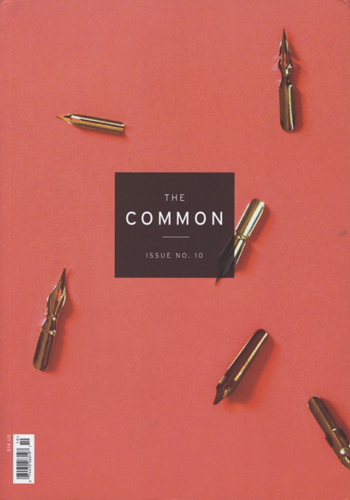The Common – October 2015
The Common magazine aims to present “bold, engaging literature and art.” Two informative essays accompanied by art definitely meet that criteria. The first, “Millennium Camera” by Jonathon Keats, is a fascinating look at a pinhole camera he created “with a one-thousand-year exposure time that will remain inside Amherst College’s Stearns Steeple until 3015” when an image over time will be captured for a future generation to see. With that in mind, there’s a wonderful surprise for current readers. On the last page of this magazine is a diagram for a Century Camera that can be cut out, assembled, and exposed for 100 years. The Common magazine aims to present “bold, engaging literature and art.” Two informative essays accompanied by art definitely meet that criteria. The first, “Millennium Camera” by Jonathon Keats, is a fascinating look at a pinhole camera he created “with a one-thousand-year exposure time that will remain inside Amherst College’s Stearns Steeple until 3015” when an image over time will be captured for a future generation to see. With that in mind, there’s a wonderful surprise for current readers. On the last page of this magazine is a diagram for a Century Camera that can be cut out, assembled, and exposed for 100 years.
Following Keats’s piece is “The Story Behind the Scenes” by Morgan Adams. Adams was on a quest to view a discovery made in 2010 at the 15th century Villa La Pietra in Italy: a 250-year-old sketchbook containing more than a hundred intricate drawings by French architect and artist Jean-Joseph Chamant. Combined with images of the art and Adams’s trip, this is an interesting and enlightening read.
A third essay, Ben Shattuck’s “He’s-at-Home,” also accompanied by photos, is well-balanced, both funny and serious at the same time. Shattuck journeys to the home of 80-year-old Connie Congdon, widow of publishing editor Tom Congdon, to see the 120-year-old plaster dildo that was found among other artifacts in her home’s chimney. The title of this essay refers to the name given to dildos in books of Yankee whale fishery. “I wanted to see one,” writes Shattuck. “Finding a real he’s-at-home would be easy, I thought. Embarrassing, but easy.”
And one other essay is worth mentioning because of its stirring coverage of a historical tragedy. “Driving to Malaga” by Todd Hearon is a 12-part overview of an early 1900’s focus on eugenics and the resulting cruel eviction of residents from Maine’s Malaga Island.
A special feature in this issue is new poetry from China, translated by Stephen Haven and Li Yongyi. A couple of the poems tend toward bleakness. For instance, these words in Yu Nu’s “The Eyewitness”:
His cap floating on the river, his soft tissues
Like severed seaweeds. This happened in 1976.
I was living alone in the garden, barely ten, frightened
At night, trembling. Have you ever heard a flower
Bloom?
Yang Jian carries on this mood, writing about another year in “1967,” the year the speaker in the poem was born:
[ . . . ] an apocalyptic year,
Destined to look at things with a destructive eye,
Sick soon after I entered the world,
Destined to look at things as a morbid man.
Tang Danhong takes her poem “You Might Have Been My Brother” in a different direction.
You might have been my ghost, especially tonight,
A shy corner of my ballet,
A painting, a flower, asking an exact identity.
On to fiction, Aaron Steven Miller writes an intriguing story, “The Bone Church,” about a young couple hitchhiking to Budapest to visit said church. Their attention is drawn to a chandelier made of human bones, the center of the intrigue: “It did not look skeletal, because it did not resemble any kind of living thing, but all the same, it was constructed from the same material, and appeared especially naked, as skeletons do.”
In a story many people can identify with, Ivan Vladislavić gives us an excerpt from his book The Folly about people’s reactions and suspicions when a new neighbor moves in. We are allowed to eavesdrop on both sides of the story. Then, in “Key Concepts in Ecology,” Michelle Ross nicely manages what seems like a cast of thousands when a “creature” is spotted outside New Zenith School. Employees are quarantined, but it’s pretty much business as usual while they wait for the creature to be annihilated.
As might be expected, some of the works herein are less appealing to me than others, but overall, The Common reveals diverse and often challenging viewpoints from proven literary talents. I encourage you to read this magazine to see if you agree.
[www.thecommononline.org]





